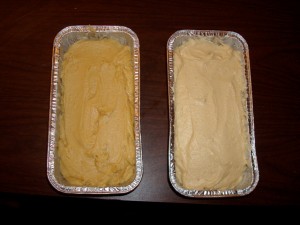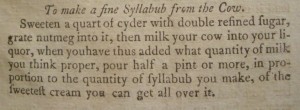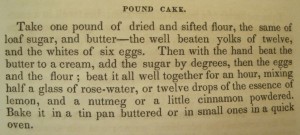If one thing connects Americans over the centuries, it’s dessert. Vanilla may have replaced rose water, the electric mixer (even the egg beater) may be heavenly gifts from a sympathetic large-bicepped ancestor, but the recipes (and the tastes) are remarkably similar. The first cookbook published in America, Amelia Simmons’ 1796 American Cookery, offers recipes for pies, puddings, cakes, tarts, custards, cookies, and biscuits. Sound familiar? The most peculiar dessert recipe is for syllabub (a relative of our holiday eggnog). But it’s the directions that are strange, not the ingredients.
Is it fair to assume that a time-traveling dessert could leave early America and end up right at home in our own kitchens? An experiment was in order.
The contenders: Two pound cake recipes (the cow was unavailable on such short notice).
From the 19th century: Sarah Josepha Hale, The Good Housekeeper, 1839.
From the 21st century: Pound Cake recipe in Martha Day, The Ultimate Book of Baking, 2005.
The Time Travelers: Diann Benti, Assistant Reference Librarian, and Jess Lepler, Hench Post-Dissertation fellow and assistant professor of History at the University of New Hampshire. One willing to beat batter for an hour, the other trying to embrace modernity with an ill-advised immersion blender.
The Scene: Mark Zanger writes in the American History Cookbook that, “As a technical note, Early American cakes are among the most difficult historical recipes to reproduce today because so many ingredients have changed” (58). Flour held more moisture and had different protein contents than those found in grocery stores today. Eggs tended to be smaller and butter often had more salt (58-9). The 1839 recipe calls for loaf sugar and suggests using rose water, both unavailable in the AAS Test Kitchen. (We added a little bit of molasses to the 1839 cake to mimic the increased moisture of loaf sugar.)
In the end, after converting a measure of weight (the pound) to volume (cups), we were left with 4 cups of flour, 2 ¼ cups sugar, and 4 sticks of butter for two loaves in the Hale recipe—just about double the recipe of Day’s one-loaf cake. Using these same ingredients, the assembled cakes would go in the oven together and remain there until they each passed the toothpick test.

The Question: The details decided, the real battle between old and new emerged, pitting the arm against the chemical: Hale’s hour of batter beating versus Day’s one teaspoon of baking powder. What would the difference mean in taste and size?
The Taste Testers: The AAS fellows. Known to gnaw on the books if left unsupervised in the evening hours, they were fair game against a pound of butter, a pound of sugar, and a pound of flour.
The Results: A blister and arm cramps at 3am that night. Oh wait. You mean how did the cakes turn out?

The Verdict: The challenge rested on the lengths one would go to create a tasty dessert. Desperate for lighter pound cake, a cook’s only real option in the 1830s was to beat air into it. So was all the labor worth it? Given the inherent biases of the testers (18th and 19th century Americanists, who as academics have been known to like it dense), Sarah Josepha Hale emerged victorious. It was universally agreed by the taste testers that while the 19th century loaf was still dense, its flavor was much richer than its 21th century opponent, and tasted very much like shortbread. Perhaps, as the modern cake mushroomed in its pan, the flavor diffused to meet the enlarged size. Some suggested the Day cake needed a sauce and others detected a chemical taste. If mixed only minimally, Hale’s cake might have had a second career as building material, but after an hour’s beating it was enjoyable and more than welcome on our table.
The Take Away: If you’re looking to recreate an 1839 dessert at your next get-together, please note that one tester characterized it as “strange,” “mealy,” and “good” all in the same sentence. Zanger tells us that as technology (e.g. iceboxes) expanded the realm of possibility in home cooking the pound cake decreased in popularity. But, pound cake remained a dessert staple in “pioneering zones and isolated areas such as Appalachia well into the twentieth century, the recipe is easy to remember and the cake works without refrigerators, yeast, or baking powder” (62).
In closing, we’ll give the last word to Mrs. Hale,
Never spread butter on cake; it is a sin against that economy and propriety which domestic rules should always exhibit; and besides, it renders the cake too rich for the stomach. The kinds of cake most apt to prove injurious are pound cake and rich plum cake. (84-5)



Related, historical ginger cookies!
A fantastic comparison, it’s almost like a school lesson on cake theory! Very interesting, although I think the old recipe is a little vague in its instructions so results could vary greatly.
Love this cake… The flavor is yummy, smells so good!